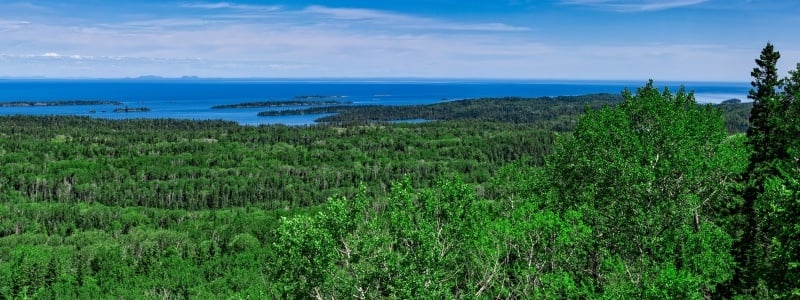In partnership with Isle Royale National Park, the Institute offers education and collaborative research to teachers, students, and researchers. We focus on science and education in the remote northwestern Lake Superior archipelago waters, designated a national park in 1931, and an international biosphere in 1980.
Isle Royale and surrounding waters are a living lab.
The wilderness is home to long-running research on wolf-moose ecology, boreal chorus frogs, nutrient cycling, and climate change. It is rich with artifacts—prehistoric mining, commercial fishing, the resort industry, and shipping.
A Natural Fit
The partnership between Michigan Technological University and Isle Royale National Park, a component of our Ecosystem Science Center, expands lifelong learning and research opportunities. We design, fund, and offer long-term programs and short-term projects. We collaborate with universities, government agencies, and the private sector for research and education that brings people of all ages and backgrounds into this spectacular one-of-a-kind environment.
About Isle Royale
The park, composed of one large island and about 400 smaller, is prized by backpackers, boaters, paddlers, anglers, shipwreck divers, and researchers—but it is the least visited in the national park system's lower 48 states. The only way to get there is by boat or seaplane.
Isle Royale is 45 miles long, and nine miles at its widest point.
Learning for All Ages
Moose watches, fishery trips, and camping—so many things to see and do on the roadless island! Here are some of the programs we've offered for children, adults, families, and educators.
Research Support
National park, federal wilderness area, and international biosphere reserve, Isle Royale offers a superlative living laboratory and field site for research in a broad range of disciplines, from the natural sciences to geology, archaeology, and wilderness ethics.
The archipelago's natural history tells the tale of ancient lava flows and glaciers, extreme climates, human impacts from mining and logging, and the ongoing influence of fluctuating moose populations.
Spruce-fir-birch forests dominate the east end of the main island; northern hardwoods dominate to the west.
But habitats are diverse, including more than 40 inland lakes, a wide variety of wetlands and forests, and microhabitats within the crevasses and splash pools of exposed rocky shorelines.
Isle Royale is home to fewer animal and plant species than the Canada, Michigan, and Minnesota mainlands closest to it. But it hosts an unusual concentration of rare and protected species, including rare plant and insect species more commonly found in arctic, alpine, and western regions (such as crow berry, butterwort, devil’s club, and the dragonfly Aeshna juncea).
Located in the transition zone between the northern hardwood and boreal forest, Isle Royale acts as an early indicator of global climate change for the species of these environments farther north in their range.
In 2008-2009, the Institute helped convene a blue-ribbon panel of academic experts to assess scientific research at Isle Royale National Park.
- Scientific and popular publications are available from the Isle Royale and Keweenaw Parks Association (IRKPA).
Moosewatch Expeditions
The Institute assists the Isle Royale Wolf-Moose Project to arrange volunteer expeditions into the backcountry to collect field data essential to continued monitoring and research of wolf and moose populations.
